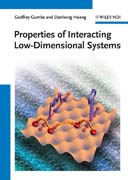
Filling the gap for comprehensive coverage of the realistic fundamentals and approaches needed to perform cutting-edge research on mesoscopic systems, thistextbook allows advanced students to acquire and use the skills at a highly technical, research-qualifying level. Starting with a brief refresher to get all readers on an equal footing, the text moves on to a broad selection of advanced topics, backed by problems with solutions for use in classrooms as well asfor self-study. Written by authors with research and teaching backgrounds from eminent institutions and based on a tried-and-tested lecture, this is a must-have for researchers, research students and instructors involved with semiconductor junctions, nanostructures and thin film systems. INDICE: Preface. References. Part One Linear Response of Low Dimensional Quantum Systems. 1 Introduction. 1.1 Second-Quantized Representation for Electrons. 1.2 Second Quantization and Fock States. 1.3 The Boson Case. 1.4 The Fermion Case. 1.5 The Hamiltonian of Electrons. 1.6 ElectronPhonon Interaction. 1.7 Effective ElectronElectron Interaction. 1.8 Degenerate Electron Gases. 1.9 Ground-State Energy in the High Density Limit. 1.10 Wigner Solid. 1.11 The Chemical Potential of an Ideal Bose Gas and BoseEinstein Condensation. 1.12 Problems. References. 2 The KuboGreenwood Linear Response Theory. 2.1 Fluctuations and Dissipation. 2.2 Nyquists Relation. 2.3 Linear Response Theory. 2.4 The Density Matrix and Quantum Statistics. 2.5 Kubos Theory. 2.6 The Kubo Equation. 2.7 FluctuationDissipation Theorem. 2.8 Applications. 2.9 Kinetic Equation for Elastic Processes. 2.10 Problems. References. 3 Feynman Diagrammatic Expansion. 3.1 General Formalism. 3.2 Functional Derivative Techniques. 3.3 Unrenormalized Expansion for G and ú. 3.4 Renormalized Expansion for Self-Energy ú. 3.5 The Schrödinger Equation in the HartreeFock Approximation. 3.6 Screened External Potential. 3.7 Retarded Polarization Function. 3.8 RPA for the Polarization Function. 3.9 Problems. References. 4 Plasmon Excitations in Mesoscopic Structures. 4.1 Linear Response Theory and Collective Excitations. 4.2 A Linear Array of Nanotubes. 4.3 A Linear Array of Quantum Wires. 4.4 Coupled Half-Plane Superlattices. 4.5 Problems. References. 5 The Surface Response Function, EnergyLoss and Plasma Instability. 5.1 Surface Response Function. 5.2 Electron Energy Loss for a Planar Surface. 5.3 Plasma Instability for a Planar Surface. 5.4Energy Transfer in Nanotubes. 5.5 Problems. References. 6 The Rashba SpinOrbit Interaction in 2DEG. 6.1 Introduction to SpinOrbit Coupling. 6.2 SpinOrbit Coupling in the Dirac Equation. 6.3 Rashba SpinOrbit Coupling for a Quantum Wire. 6.4 SOI Effects on Conductance and Electron-Diffusion Thermoelectric Power.6.5 Problems. References. 7 Electrical Conductivity: the Kubo and LandauerBüttiker Formulas. 7.1 Quantum Mechanical Current. 7.2 The Statistical Current. 7.3 A Greens Function Formalism. 7.4 The Static Limit. 7.5 Model and Single-Particle Eigenstates. 7.6 Averaged Conductivity. 7.7 Applications to One-Dimensional Density Modulated 2DEG. 7.8 Scattering Theory Formalism. 7.9 Quantum Hall Effect. 7.10 Problems. References. 8 Nonlocal Conductivity for a Spin-Split Two-Dimensional Electron Liquid. 8.1 Introduction. 8.2 Kubo Formula for Conductivity. 8.3 The Self-Energy and Scattering Time. 8.4 Drude-Type Conductivity forSpin-Split Subband Model. 8.5 Vertex Corrections to the Local Conductivity. 8.6 Numerical Results for Scattering Times. 8.7 Related Results in 3D in the Absence of SOI. References. 9 Integer Quantum Hall Effect. 9.1 Basic Principles of the Integer Quantum Hall Effect. 9.2 Fundamental Theories of the IQHE. 9.3 Corrections to the Quantization of the Hall C
- ISBN: 978-3-527-40894-8
- Editorial: Wiley-VCH
- Encuadernacion: Cartoné
- Páginas: 392
- Fecha Publicación: 15/06/2011
- Nº Volúmenes: 1
- Idioma: Inglés
